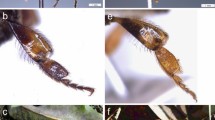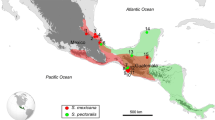Abstract
Phenotypic and molecular differences were previously found in populations of the endangered stingless bee Melipona beecheii from two extremes of its geographic range. In this study we combine the use of morphometric and molecular tools, with the aim of investigating patterns of phenotypic and molecular variation in populations across Mesoamerica. Morphometric analyses showed that bees from Mexico have significantly smaller body size compared with populations from Central America, forming two separated groups. Bayesian analysis of the ITS1 spacer of the ribosomal gene also showed the existence of two clusters: one composed by the Mexican populations, and another in which the Central American ones assembled (Guatemala, El Salvador, Nicaragua and Costa Rica). The combined results confirm the presence of two taxonomic units: one distributed in southern Mexico (ranging from the Yucatan peninsula to the north of Guatemala), and a Central American unit found from the southern part of Guatemala down to Costa Rica. These units should be considered separately under conservation programs and therefore, human assisted colony exchange between them should be avoided.




Similar content being viewed by others
References
Arias MC, Sheppard WS (1996) Molecular phylogenetics of honey bees subspecies (Apis mellifera L.) inferred from mitochondrial DNA sequences. Mol Phylogenet Evol 5:557–566
Ayala R (1999) Revisión de las abejas sin aguijón de Mexico (Hymenoptera: Apidae: Meliponini). Folia Entomol Mex 106:1–123
Batalha-Filho H, Waldschmidt AM, Campos LAO, Tavares MG, Fernandes-Salomão TM (2010) Phylogeography and historical demography of the neotropical stingless bee Melipona quadrifasciata (Hymenoptera, Apidae): incongruence between morphology and mitochondrial DNA. Apidologie 41(5):534–547
Camargo JMF, Moure JS, Roubik DW (1988) Melipona yucatanica new species (Hymenoptera, Apidae, Meliponinae), stingless bee dispersal across the Caribbean Arc and Post-Eucene Vicariance. Pan-Pacific Entomol 64:147–157
Carr DL (2008) Farm households and land use in a core conservation zone of the maya biosphere reserve, Guatemala. Hum Ecol 36:231–248
Cauich O, Quezada-Euán JJG, Macias-Macias O, Reyes-Oregel V, Medina-Peralta S, Parra-Tabla V (2004) Behaviour and pollination efficiency of Nannotrigona perilampoides (Hymenoptera:Meliponini) on greenhouse tomatoes (Lycopersicon esculentum) in subtropical Mexico. J Econ Entomol 97(2):475–481
Crandall KA, Bininda-Emonds ORP, Mace GM, Wayne RK (2000) Considering evolutionary processes in conservation biology. Tree 15:290–295
De la Rúa P, May-Itzá WDJ, Serrano J, Quezada-Euán JJG (2007) Sequence and RFLP analysis of the ITS2 ribosomal DNA in two Neotropical social bees, Melipona beecheii and Melipona yucatanica (Apidae, Meliponini). Insect Soc 54:418–423
Diniz-Filho JAF, Pignata MIB (1994) Quantitative genetics of multivariate morphometric variation in the neotropical stingless bee, Scaptotrigona postica (Hymenoptera, Meliponinae). Rev Bras Genet 17:259–265
Echazarreta CM, Quezada-Euán JJG, Medina ML, Pasteur KL (1997) Beekeeping in the Yucatan peninsula, development and current status. Bee World 78:115–127
Ellis JS, Knight TM, Carvell C, Goulson D (2006) Cryptic species identification, a simple diagnostic tool for discrimination between two problematic bumblebee species. Mol Ecol Notes 6:540–542
Eltz T, Zimmermann Y, Pfeiffer C, Ramirez Pech J, Twele R, Francke W, Quezada-Euán JJG, Lunau K (2008) An olfactory shift is associated with male perfume differentiation and species divergence in orchid bees. Curr Biol 18:1844–1848
Engels W, Imperatriz-Fonseca VL (1990) Caste development, reproductive strategies and control of fertility in honeybees and stingless bees. In: Engels W (ed) Social Insects, an evolutionary approach to castes and reproduction: 166–230. Springer Verlag, Berlin
Fernandes-Salomão TM, Rocha RB, Campos LAO, Araújo EF (2005) The first internal transcribed spacer (ITS-1) of Melipona species (Hymenoptera, Apidae, Meliponini), characterization and phylogenetic analysis. Insect Soc 52:11–18
Fletcher DJC, Crewe RM (1981) Nest structure and thermoregulation in the stingless bee Trigona (Plebeina) denoiti Vachal Hymenoptera, Apidae. J Entomol Soc S Afr 44:183–196
Francisco FO, Nunes-Silva P, Francoy TM, Wittmann D, Imperatriz-Fonseca VL, Arias MC, Morgan ED (2008) Morphometrical, biochemical and molecular tools for assessing biodiversity. An example in Plebeia remota (Holmberg, 1903) (Apidae, Meliponini). Insect Soc 55:231–237
Francoy TM, Grassi ML, Imperatriz-Fonseca VL, May-Itzá WDJ, Quezada-Euán JJG (2011) Geometric morphometrics of the wing as a tool for assigning genetic lineages and geographic origin to Melipona beecheii (Hymenoptera: Meliponini). Apidologie. doi:10.1007/s13592-011-0013-0
Fraser DJ, Bernatchez L (2001) Adaptive evolutionary conservation: towards a unified concept for defining conservation units. Mol Ecol 10:2741–2752
Freitas BM, Imperatriz-Fonseca VL, Medina LM, Kleinert AM, Nates-Parra G, Galetto L, Quezada-Euán JJG (2009) Diversity, threats and conservation of native bees in the Neotropics. Apidologie 40:332–346
Gompert Z, Nice CC, Fordyce JA, Forister ML, Shapiro AM (2006) Identifying units for conservation using molecular systematics: the cautionary tale of the Karner blue butterfly. Mol Ecol 15:1759–1768
González-Acereto JA (2008) Cría y manejo de abejas nativas sin aguijón en Mexico. Eds. Universidad Autónoma de Yucatan/Secretaria de Fomento Agropecuario y Pesquero/Fundación Produce Yucatan. pp 177. ISBN 970-9850-04-0
González-Acereto JA, Quezada-Eúan JJG, Medina-Medina LA (2006) New perspectives for stingless beekeeping in the Yucatan: results of an integral program to rescue and promote the activity. J Apicul Res 45:234–239
Hartfelder K, Engels W (1992) Allometric and multivariate analysis of sex and caste polymorphism in the neotropical stingless bee, Scaptotrigona postica. Insect Soc 39:251–266
Hebert PDN, Cywinska A, Ball SL, DeWaard JR (2003) Biological identifications through DNA barcodes. Proc R Soc B 270:313–321
Hebert PDN, Penton EH, Burns JM, Janzen DH, Hallwachs W (2004) Ten species in one, DNA barcoding reveals cryptic species in the neotropical skipper butterfly Astraptes fulgerator. Proc Natl Acad Sci USA 101:14812–14817
Ji Y, Zhang D, He L (2003) Evolutionary conservation and versatility of a new set of primers for amplifying the ribosomal internal transcribed spacer regions in insects and other invertebrates. Mol Ecol Notes 3:581–585
Kerr WE (1960) Evolution of communication in bees and its roles in speciation. Evolution 14:386–387
Kerr WE (2002) Extinçao de especies, a rande crise biologica do momento e como afeta os meliponineos. In: Garófalo C A (ed) Anais do V encontro sobre abelhas, Riberao Preto, pp 4–9
Kerr WE, Maule V (1964) Geographic distribution of stingless bees and its implications (Hymenoptera, Apidae). J New York Entomol Soc 72:2–18
Kimura M (1980) A simple method for estimating evolutionary rate of base substitutions through comparative studies of nucleotide sequences. J Mol Evol 16:111–120
May-Itzá WDJ, Quezada-Euán JJG, De la Rúa P (2009) Intraspecific variation in the stingless bee Melipona beecheii assessed with PCR-RFLP of the ITS1 ribosomal DNA. Apidologie 40:549–555
May-Itzá WDJ, Quezada-Euán JJG, Medina LM, Enríquez E, De la Rúa P (2010) Morphometric and genetic differentiation in isolated populations of the endangered Mesoamerican stingless bee Melipona yucatanica (Hymenoptera, Apoidea) suggest the existence of a two species complex. Conserv Genet 11:2079–2084
Michener CD (1979) Biogeography of the bees. Ann Missouri Bot Gard 66:277–347
Michener CD (2007) The bees of the world, 2nd edn. Johns Hopkins, Baltimore
Moritz C (2002) Strategies to protect biological diversity and the evolutionary processes that sustain it. Syst Biol 51:238–254
Moure JM, Urban D, Melo GAR (2007) Catalogue of bees (Hymenoptera, Apoidea) in the Neotropical Region. Sociedade Brasileira de Entomologia, Curitiba
Murray TE, Fitzpatrick U, Brown MJF, Paxton RJ (2008) Cryptic species diversity in a widespread bumble bee complex revealed using mitochondrial DNA RFLPs. Conserv Genet 9:653–666
Palma GJ, Meléndez-Ramirez V, Quezada-Euán JG, Valdovinos-Nuñez GR, Rejón M (2008) Comparative efficiency of Nannotrigona perilampoides, Bombus impatiens (Hymenoptera: Apoidea), and mechanical vibration on fruit production of enclosed habanero pepper. J Econ Entomol 101(1):132–138
Peakall R, Smouse PE (2006) GENALEX 6: genetic analysis in Excel. Population genetic software for teaching and research. Mol Ecol Notes 6:288–295
Pfenninger M, Schwenk K (2007) Cryptic animal species are homogeneously distributed among taxa and biogeographical regions. BMC Evol Biol 7:121. doi:10.1186/1471-2148-7-121
Posada D, Crandall KA (1998) Modeltest, Testing the model of DNA. Bioinformatics 14:817–818
Primack RB (2004) A Primer of Conservation Biology, 3rd edn. Sinauer Associates, Sunderland, Massachusetts
Quezada-Euán JJG, May-Itzá WDJ, González-Acereto JA (2001) Meliponiculture in Mexico, Problems and perspectives for development. Bee World 82:160–167
Quezada-Euán JJG, Paxton RJ, Palmer KA, May-Itzá WDJ, Tay WT, Oldroyd BP (2007) Morphological and molecular characters reveal differentiation in a Neotropical social bee, Melipona beecheii (Apidae, Meliponini). Apidologie 38:247–258
Quezada-Euán JJG, López-Velasco A, Pérez-Balam J, Moo-Valle H, Velazquez-Madrazo A, Paxton RJ (2011) Body size differs in workers produced across time and is associated with variation in the quantity and composition of larval food in Nannotrigona perilampoides (Hymenoptera: Meliponini). Insec Soc 58:31–38
Ronquist F, Huelsenbeck JP (2003) MrBayes 3, Bayesian phylogenetic inference under mixed models. Bioinformatics 19:1572–1574
Roubik DW (1990) Mate location and mate competition in males of stingless bees (Hymenoptera:Apidae:Meliponinae). Entomol Gener 15:115–120
Roubik DW, Aluja M (1983) Flight ranges of Melipona and Trigona in Tropical forest. J Kansas Entomol Soc 56:217–222
Samejima H, Marzuki M, Nagamitsu T, Nakashizuka T (2004) The effects of human disturbance on a stingless bee community in a tropical rainforest. J Biol Conserv 120:577–587
Schwarz HF (1932) The genus Melipona, the type genus of the Meliponidae or stingless bees. Bull Amer Mus Nat His 63:231–460
Sittipraneed S, Sihanuntavong D, Klinbunga S (2001) Genetic differentiation of the honey bee (Apis cerana) in Thailand revealed by polymorphism of a large subunit of mitochondrial ribosomal DNA. Insect Soc 48:266–272
Sommeijer MJ, Bruijn LLM (1995) Drone congregations apart from the nest in Melipona favosa. Insect Soc 42:123–127
Sousa RO, Moretto G, Arias MC, Del Lama MA (2008) Differentiation of Melipona quadrifasciata L. (Hymenoptera, Apiadea, Meliponini) subspecies using cytochrome b PCR-RFLP patterns. Genet Mol Biol 30:445–450
Tamura K, Dudley J, Nei M, Kumar S (2007) MEGA4, Molecular evolutionary genetics analysis (MEGA) software version 4.0. Mol Biol Evol 24:1596–1599
Tavares MG, Santos LA, Arantes BA, Meneses LD, Pereira BAH, Guimarães CR, Fernández-Salomão TM, de C Oliveira L (2007) Genetic divergence between populations of the stingless bee uruçu amarela (Melipona rufiventris group, Hymenoptera, Meliponini), Is there a new Melipona species in the Brazilian state of Minas Gerais? Genet Mol Biol 30:667–675
van Veen JW, Sommeijer MJ, Meeuwsen F (1999) Behaviour of drones in Melipona (Apidae, Meliponini). In: van Veen JW (ed) Colony reproduction in stingless bess. Litografía e Imprenta LIL, SA, San José, pp 29–42
Villanueva-G R, Buchmann S, Donovan AJ, Roubik DW (2005) Extinction of Melipona beecheii and traditional beekeeping in the Yucatan peninsula. Bee World 86(2):35–41
Vit P, Medina M, Enríquez E (2004) Quality standards for medicinal uses of Meliponinae honey in Guatemala, Mexico and Venezuela. Bee World 85(1):2–5
Vogler AP, Desalle R (1994) Diagnosing units of conservation management. Conserv Biol 8:354–363
Waldschmidt AM, Barros EG, Campos LAO (2000) A molecular marker distinguishes the subspecies Melipona quadrifasciata quadrifasciata and Melipona quadrifasciata anthidioides (Hymenoptera, Apidae, Meliponini). Genet Mol Biol 23:609–611
Wiens JJ, Donoghue MJ (2004) Historical biogeography, ecology and species richness. Tree 19:639–644
Wiley EO (1981) Phylogenetics, The theory and practice of phylogenetics systematics. John Wiley and Sons, New York
Winker K (2005) Sibling species were first recognized by William Derham (1718). Auk 122:706–707
Wongsiri S, Limbipichai K, Tangkanasing P, Mardan M, Rinderer T, Sylvester HA, Koeniger G, Otis G (1990) Evidence of reproductive isolation confirms that Apis andreniformis (Smith, 1858) is a separate species from sympatric Apis florae (Fabricius, 1787). Apidologie 21:47–52
Acknowledgments
We thank Miguel Guzmán, Manuel Rincón, Fernando Ramírez, Marta Aguilar, Eunice Enríquez, Míriam Corrales and stingless bee keepers for providing the samples. Irene Muñoz Gabaldón and Carlos Ruiz Carreira for their help during the molecular analyses. We also thank two anonymous reviewers for helpful comments. This study was supported by projects MUTUAL “Mutualismos y abejas en paisajes tropicales: riesgos y rescate para la biodiversidad y la agricultura” (4293 “Fondo de Cooperación Internacional en Ciencia y Tecnología UE – Mexico” (FONCICYT) and “Conservación de las abejas sin aguijón de Mexico (Hymenoptera: Meliponini): identificación de especies crípticas e indicadores de diversidad genética” (SEP CONACYT 103341-Z).
Author information
Authors and Affiliations
Corresponding author
Rights and permissions
About this article
Cite this article
de J. May-Itzá, W., Quezada-Euán, J.J.G., Ayala, R. et al. Morphometric and genetic analyses differentiate Mesoamerican populations of the endangered stingless bee Melipona beecheii (Hymenoptera: Meliponidae) and support their conservation as two separate units. J Insect Conserv 16, 723–731 (2012). https://doi.org/10.1007/s10841-012-9457-4
Received:
Accepted:
Published:
Issue Date:
DOI: https://doi.org/10.1007/s10841-012-9457-4




